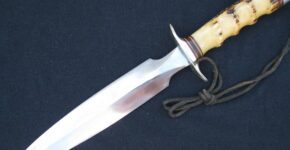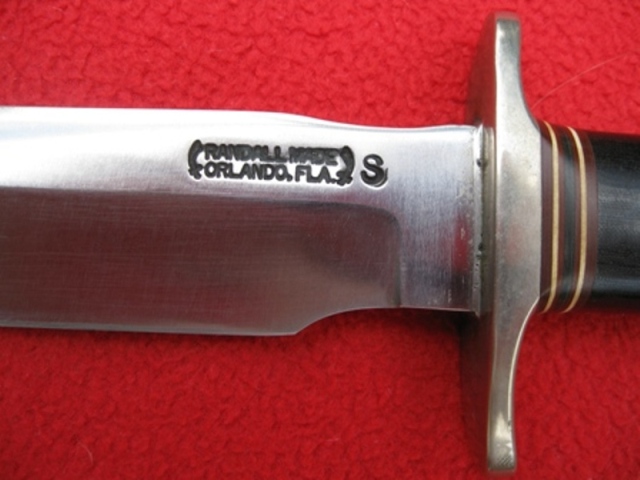


The “SS” stamping of Randall forged blades began in 1963, when RMK started designating stainless blades as such. It may have run into 1964, but it was not done this way much beyond a six month duration, and that may even be generous. The low “S” stamp ran after that for a year or so, and probably into 1965. The separate “S” stamp ran from that time through 1968 and into 1969.
Note that while productions dates are pretty clear, you could still receive a blade stamped in an earlier version but made into a complete knife at a later time. This would happen most often on less popular models that may have had some earlier stainless forgings sitting in a bin to be retrieved for use at a later time. You will see this most commonly on separate “S” models primarily because this stamping was used for a longer period of time into the late 1960’s, therefore resulting in more blades stamped in this fashion, and occasionally showing up on knives into the mid 1970’s. That would be followed by the low “S” stamp and then the “SS” stamp of which you will unlikely find few if any knives made much beyond the actual date of blade forging. It is possible that these early “SS” stamped blade were “made to order” in the sense that stainless orders were few and far between at that time. I do know of one collector that purchased a model 8 from the early 1980’s with a low “S” blade! Of course this instance is somewhat of an anomaly.
Pete Hamilton, former shop foreman, emphatically told me many years ago during one of several discussions that the first logo stamp incorporating the “S” arrived in the shop during 1969. He said and as we all know, they had previously done the “S” stamp independently of the RMK logo but on several occasions tried incorporating the two stamps as one by various means, to include brazing or wiring the two stamps together. Neither method was satisfactory to say the least, so eventually an inclusive “S” Randall Made Knives stamp was ordered.
Note that the first inclusive “S” stamp can have the appearance of being a separate “S” stamped blade due to the distance from the right scimitar to the “S”. If you look closely and see enough of them, you can tell the difference rather easily. Additionally the shape of the “S” changed a bit that was more balanced in shape top to bottom.
Being that the use of the “SS” stamping was early and of such short duration, compounded with the fact that the percentage of blades requested out of stainless steel was very small as a percentage of total production at that time, there are not too many examples around. I don’t know but would guess it is no more than a couple hundred, based solely on the quantity I have observed over the years.
Also note that there are extant examples that are “SS” etched. The more common (if you can say that) of the two seems to be the etched logo as well as the etched “SS”, although I have seen some with a stamped logo and an etched “SS” designation, probably the least common variation. This may be due again to the fact that not too many knives were ordered in stainless steel during that period, so a forged stainless blade may not have gotten stamped for one reason or another. Perhaps the forger forgot he was forging stainless. In any case, the three variations do exist – logo and “SS” stamped, logo stamped and “SS” etched, and both logo and “SS” etched.
The low “S” stamping is located at the bottom of the ricasso or somewhere in the vicinity. This method lasted for a year or so. There are more examples of this stamping versus the “SS”, not only because it was done for a longer period, but also due the increase in knives with stainless blades partly due to the build up of the United States involvement in the Viet Nam war. The low “S” stamp was used from 1964 into 1965. There also seems to be more models exhibiting the low “S” stamp.
There was a term “wandering S” dreamed up by someone awhile back that has been used by a few folks to describe an “S” stamp say midway up the ricasso. Apparently an effort was made to stamp it low but perhaps it was thought not that important, or perhaps sometimes maybe you just miss a bit. In other words, I do not think it was a conscious decision to have a progression of the “S” stamp location from low, to mid, to up (or vice versa) by the logo. For our purposes, this location of the stamp is a low “S” to the collector.
We also need to consider that some Randall Made forged blades were etched with a logo and the “S” because of an initial weak stamp that was buffed out of the forging. This is not unique to stainless steel blades only, but can also be found on carbon steel blades. Note that all Solingen blades, carbon and stainless, have etched Randall Made logos and etched “S” if stainless.
So there you have it, the timeline of Randall Made Knives’ methods used to designate stainless steel blades.
Typical separate “S” stamp on a seven spacer knife
Separate “S” stamp on a 1973-1976 vintage three thick two thin spacer model 1. This documented 1974 model 1 is an example of an earlier blade forging on a later knife. Not much later, only a few years, but later nonetheless. This knife was put together after the inclusive “S” stamp was being used by the shop.
This is also a 73-76 model three thick two thin spacer model 1, but in contrast with the knife pictured to the left, this one has the first inclusive “S” stamp. Note the distance between the right scimitar in the logo with the “S” almost giving the apperance of a separate “S”. Also note the “S” is more balanced in shape top to bottom versus the individual “S” stamp used prior this one. This is one to study closely.